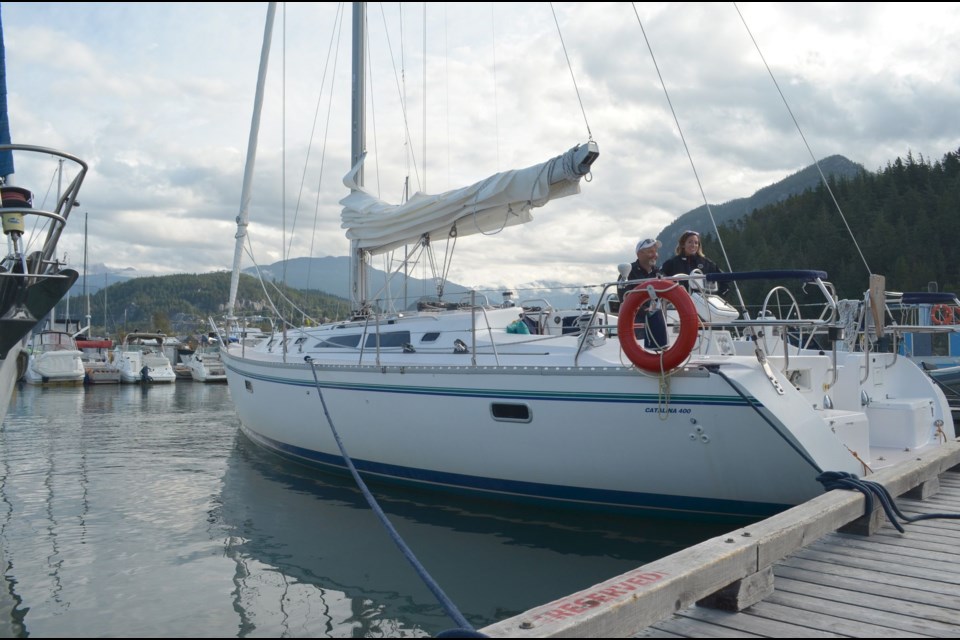It's a calm morning in Howe Sound. A wall of mist hovers over the glassy waters, and soft morning sunlight gradually pierces through the fog.
A Catalina 400 sailboat skims through the Mamquam Blind Channel southwards toward Sp’akw’us Feather Park (formerly Newport/Nexen Beach) and begins to arc toward the western shoreline of the sound.
It's Sept. 10 and chief mate David Crewson is providing a tour to The Chief, and skipper Harli Callighen is manning the helm.
Crewson, who co-owns Canadian Coastal, a boating service in Squamish, said one of the things that he's learned about sailing is that it's a self-selecting activity.
"It acts as a natural filter," he said.
"People who want to come sailing are typically very interesting people. We've hosted everyone from [seven-week] old babies to 90-year-old grandmothers...the memories start with people."
Crewson and Callighen didn't say it, but they themselves are interesting people, too — they have a number of stories and memories out on the water to share.
Perhaps some of the most notable things they've seen involve the local wildlife.
That morning, the dorsal fins of salmon periodically inch briefly out of the water and disappear again. A seal curiously bobs up above the surface, revealing its eyes and snout.
A heron poses by the water, statuesque and unmoving.
This season, Crewson said he's seen a fair share of wildlife.
There've been two orca sightings. One encounter involved northern resident whales, while the other sighting involved transients that were chasing a seal.
Porpoises have made appearances in the sound and dolphins have glided through the waters as well.
Crewson said it's been remarkable to see the wildlife, given the sound was considered dead a few decades ago.
However, while the animals are often a spectacular sight to see, the best memories out on the water, he said, are with the people.
It's especially true this year, as folks have been able to start reconnecting after a long period of separation triggered by the pandemic.
"We've had a lot of private charters. Families and friends that want to reconnect."
"Everyone seems to appreciate the social interaction a lot more," added Callighen. "It's nice to witness it."
Crewson said it's also special to watch how people interact with the environment.
In the case of the orcas, both sightings involved clients that were "from a demographic that their Instagram photos were very important," he said with a laugh.
"When you're privileged to see something like the appearance of an orca, you can't capture that moment on a cell phone. Within minutes, the cell phones disappear and people become far more present. And it's moments that they may not have anticipated and may not have not necessarily valued prior to that actual instance."
Midway through that sentence, he pointed out a salmon breaking through the water.
But the memories of people extend beyond just sightseeing.
"We always joke that we've actually brought back more people than we've brought with us," Crewson said.
"We spend a lot of time out here. When other vessels are in need of assistance, we have both a legal and moral obligation to help."
In the most memorable of those cases, he said that he and his crew were out for a late evening sail with guests.
They were the last boat on the water.
"We saw something that didn't look right. So we went over to investigate. It turns out it was a capsized vessel with two people in the water. And they had been in the water for about 10 minutes and [were] not in very good shape. So, if we had not noticed them and if we had not been on the water, I don't think it would've ended well for them."
Fortunately, they were able to bring the pair — a father and his young son who'd been on a jetski — onboard.
Both had life jackets on, but the water was extremely cold.
Crewson said that the human body loses control over its muscles at those temperatures after about 10 minutes.
The crew brought them to shore and they were rushed off to the hospital.
It's important for people to get educated, as many people often underestimate the local winds and currents, he added.
Crewson's time on the water has also allowed him to observe how the land has been changing.
And those changes have become particularly stark this summer, as climate change has been blamed for the record temperatures that gripped Squamish and beyond.
As the boat drifts towards the western shores of the sound, Crewson points out a wet rock.
It used to be a small scenic waterfall year-round, but this summer it's diminished to the point that it's become nothing much to look at.
That wasn't always the case.
It's a place with a special history, as the postcard-perfect view has made it a place where Crewson has brought some special guests.
As the boat pulled over to the falling water once, a couple became engaged, he recalled.
Crewson said the waterfall would likely be back in November.
Far in the distance, Shannon Falls has also started to look thin and stringy, compared with the usual roaring torrents easily visible from great distances.
The boat starts working its way back.
As the morning mist dissipates, the silhouettes of two paddleboarders become visible in the golden light.
it makes for a good shot, and Crewson knows this.
He gets out his camera, points and the shutter starts firing away.
The boat gets within shouting distance of the paddlers and Crewson waves to the pair, who wave back.
They ask each other how their day's going, and Crewson says he has great shots of them.
"Beautiful morning!...We got some nice pictures of you in the fog bank!" he exclaims.
The best memories out on the water are with people.



